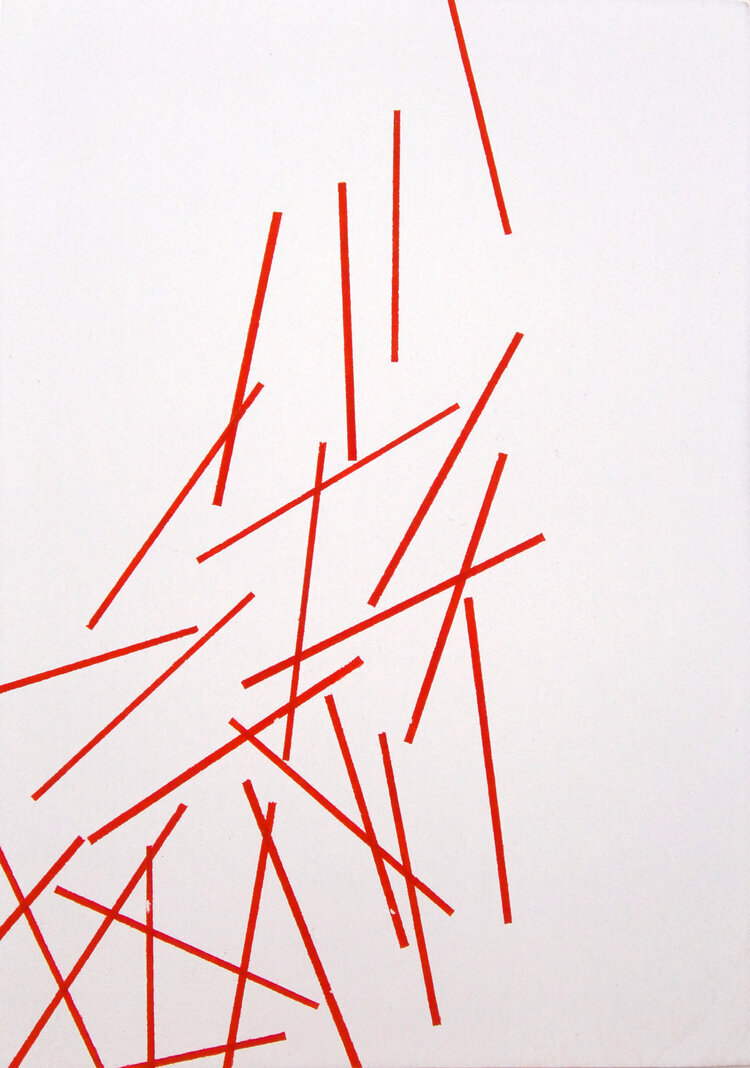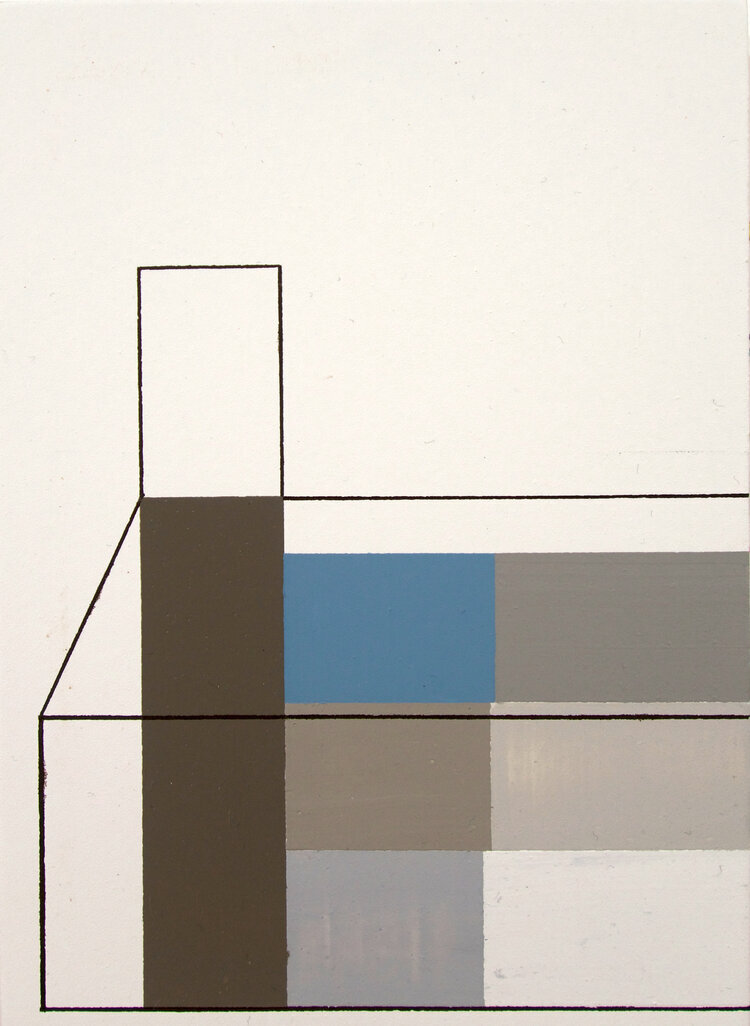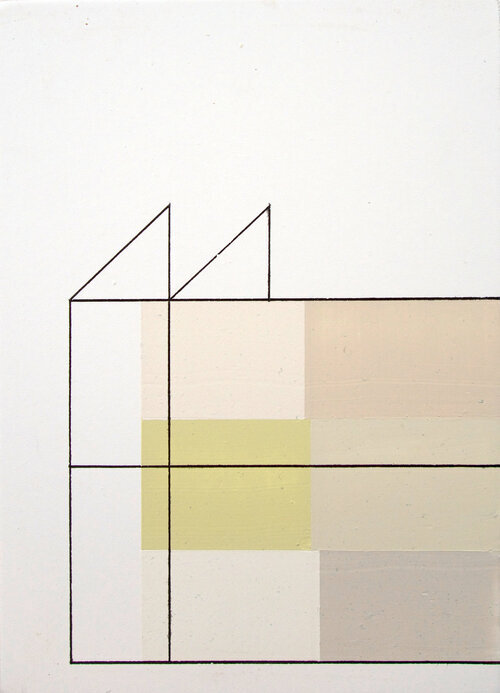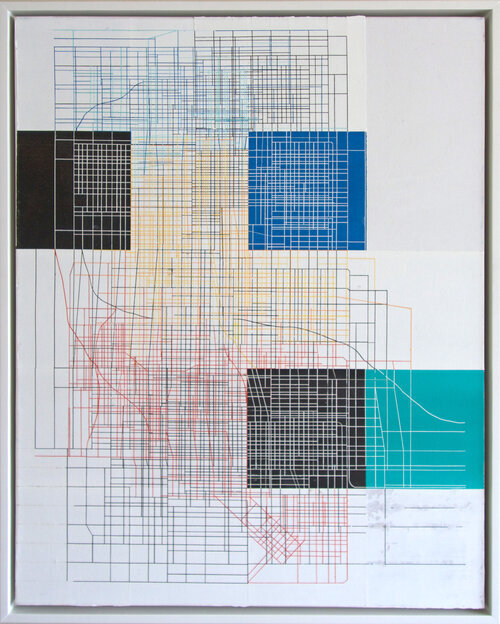Justin N. Kim
Untitled acrylic on panel, 7” x 5”, 2020
You’re a new addition to the crayon box: Which color are you and why?
Do we need another crayon in the box? Maybe I’m the pencil sharpener in the bottom of the crayon box, rather than the crayon.
How did you become interested in art?
I was born in Korea and as a child, I was introduced to many extra curricular activities and drawing was one of them that I was keen to. I kept drawing even after my family came over to the States. As a child, it was more than strange to see and live in a place where I didn’t speak the language and didn’t know the culture. I had brought some comic books with me that I’d read over and over because I didn’t know any English. The drawing style was enticing and led me to draw in the same manner.
What has your path to art look like?
I was good at drawing and I liked that I was good at it. Positive reinforcement from people led me to keep it up through middle and high school. Drawing was my forte, but then I was introduced to painting from an intro painting course at university. The act of using a brush was laborious because I was used to drawing using something with a sharp tip. Also at the same time, the material change from pen/pencil to oil paint was a big schism, but it was fun so I kept painting. I started to paint in a style of loosely constructed images, like my drawings, something like Matisse or Van Gogh, but more influenced with comic/manga style.
Soon after I was working with oil paint, I saw an abstract painting in a TV show called Mad Men and I was amazed by it. I found out the artist was named Jenny Gray from Oregon. I looked at her work and was introduced to a whole new genre. I just had to know more about this style/genre. I drove up there and had a studio visit with her in Oregon and we still stay in touch to this day. Starting to paint in a complete new style was hard and challenging, which was part of the fun. My early abstract paintings look nothing like what I’m doing today.
I knew I was going to keep making paintings and that I should continue my education. The switch in painting style was vital because had I not encountered the painting, I wouldn’t have started painting abstract paintings, nor would I be here. By this point, I had some influences that I was keen to- maps, skyscrapers, and cities, for their own ecosystem that they were functioning upon. I had a painting in my portfolio that I finished in 2014 titled Arrested Development, which captures what I wanted to do. I finished my credential program and continued to a graduate program at CSU Northridge in 2015.
I was painting a lot in grad school. I painted some paintings that I’d never even thought of painting, which turned out to be some cool paintings. I finished my grad program in 2018, with a painting called Modern Age as one of my thesis pieces. It is composed of sixteen detachable small wood panels with each panel containing imagery that looks like components found on a circuit board. This painting improved on the idea from Arrested Development a lot more and paved the way for future map paintings.
Who are other artists that have influenced your work?
I enjoy the small geometric paintings by Alain Biltereyst, I saw his small paintings on Instagram and was lucky to see them in person. Being in LA without a lot of space made me want to make small paintings, and I seem to enjoy 18 x13 cm 7 x 5 inches the best when I do make small paintings.
I also enjoy Sarah Morris and Tomory Dodge’s geometric paintings, for being big scaled, compositionally sound, and neatly painted, in two different ways.
I enjoy John McLaughlin’s paintings a lot, for the relationship between colors and compositions. I tend to think of his paintings as paintings that say something good by saying little.
Geometric shapes factor a lot into your work, what is it about geometric art that appeals to you?
I got into geometric shapes when I became drawn to the unique structures and landscapes with layouts and architecture of various cities. For example, New York City has a massive infrastructure with a build-up philosophy and at the same time Los Angeles has a build-out philosophy and that results in different infrastructures. Not only did I realize that the grid consists of lines and squares and rectangles, the best way for me to capture the impression using painting is with simple shapes. I didn’t want to try to paint three dimensionally because that would be taking it literally and if I did that, I might as well photograph them, not paint.
I also got into gadgets and took them apart because looking at computer chips was verisimilitude to looking at digital maps/grid or looking out the plane window from high up. The idea of different components coming together and making a bigger component with its ecosystem was keen to me because if the rules and the components didn’t exist, only chaos ensued. This was helpful in a way that looking at aerial view maps was not, because I learned that while cities were limited to their geography and topography, man-made systems are not limited to the physical space, thus able to take on many grounds and able to have interesting compositions. Another thing I learned from studying electronics is that all the components are made in simple shapes - squares, hardedge lines, cylinders, etc. Even more abstract and hardedge than real life architecture and unique layouts.
A lot of your work appears to use subdued colors, punctuated by bursts of bright colors...how do you decide what color palette to use for a piece?
I think there’s a couple factors when it comes to how colors are picked. But there’s no palette that's planned before painting. If anything, I try to let the painting dictate or play itself out rather than me making the painting. In order for me to do that, I learned that it is easy to have a loose idea or an imagery of some kind before painting, that way I can try to come up with colors or shapes that would capture the essence of the painting as I go.
But it’s also from making iterations of one painting by exploring. Which is important to do, to go outside the comfort zone and get the information I didn’t have before. I learned a lot from making iterations of one painting. It’s challenging and the thrill I get from pushing myself to come up with something that I’ve never done before and when I do, that’s a pretty great feeling. And while making iterations, I ask myself things like “how can I keep the essence and make it different than before? or “what if I do...?” After I have different versions of one painting, I take notes of what I think is working and not working, in terms of the imagery, composition, colors etc, then I do it again and apply all the notes I took and hope it comes out better than predecessors.
Your series “Maps” is fascinating! Did living in Los Angeles or another city inspire your work? If not, what led you to create this series?
I think my being in LA is influenced a lot in my maps series. I would drive a lot for my job and see a lot of different streets here, see which streets meet each other and which ones turn into something else, which is good research for someone who paints imaginary map paintings. I’d drive and look at google maps to enhance my understanding of the city’s layouts and geography. As much as I like LA, I’m not trying to make a realistic map of it. I try to think of other places that I’ve visited, so I’m not relying on one resource. I’ve visited three other major cities in the US and not only do I genuinely enjoy seeing different and unique places, it also doubles as research, to study different areas and the culture.
I think I arrived at making abstract maps because I enjoy looking at different places and that led me to see buildings as modules, making up cities. I found that circuit boards/motherboards and maps (of cities) are the same, so I started to collect electronics to tear down. I got my first smartphone and you can open the back of the phone to change the battery and the sd card. I took that phone apart and I wanted to see more of that arrangement on the motherboard. I opened up my laptop to see the inside and watched videos of electronics being fixed or torn down. I didn’t have money to buy computers or tv just to take them apart so I just had to wait until either my own stuff broke or somebody gave me their old gadgets. Seeing different components playing each role within the board, and altogether making a computer or a phone, was fascinating. Something that is built with a purpose, while it still has its own shortcomings and imperfections, things were made to cohabitat and designed to do its job while it would last. I liked that idea a lot, and similarly wanted to capture the impression from map viewings and motherboards.
I’m still learning and growing by looking at different areas beyond the United States through google maps and watching tear down videos, and by looking at different posts on Instagram. I know that the series is continuously evolving and I’m excited for what’s coming.
What is the best piece of advice you’ve been given?
That I should paint for myself first, without allowing others’ perception of my work to dictate where it goes. That way I won’t lose the joy in the process and still be able to paint.
What does a typical studio day look like for you?
Well, before the pandemic, I would try to paint two/three hours after work, depending on days and time. But often would end up with an hour and half in, sometimes two. Some days I would finish work later than others leaving less time to paint. While painting, I would have two beers. During weekends, I would either paint Saturday or Sunday, for about an hour or two, but not both days.
Nowadays, I’ve started a series of small experimental-abstract paintings. My painting hours have more than doubled, I don’t time my sessions but I paint for four to five hours every day. Either I paint nonstop or I paint in little sessions, a little in the mornings and again at night time. When I’m painting these small paintings, I try to keep the flow going, because it’s difficult to continue from where I left off. My rule still applies to the weekends but I mostly paint on Sundays.
How has the COVID pandemic affected your practice?
The silver lining of the pandemic for me is that I am able to paint much more. I don’t think I would have had the chance to ever catch up to where I am now pre-pandemic. This pandemic has provided me with a lot of time that I am able to challenge myself. Not just painting longer hours but I came up with a series of experimental paintings that requires me to explore in composition, style, technique, and much more. It is rewarding to push myself and see different paintings that are much different from the ones that I’ve been doing and other people have seen. I hope to incorporate some new tricks that I’ve learned in my paintings from now on.
How has your practice changed over time?
I think my practice grew a lot while I was in grad school. I was just painting a lot because I wanted to paint, and the program allowed me to have not only the space to do it, but also a lot of time to explore and paint, which looking back I appreciate a lot.
I still have fun painting today. I have not changed anything when it comes to how I paint. There’s something in each act that I can’t say in words that I crave and become amazed by. I still use the same knife and same tape, sometimes I sketch out some ideas and sometimes I don’t. I’ve been painting standing up in front of a work table, and my neck is bent almost ninety degrees and my posture would take a hit. So I’ve been thinking about painting sitting down to preserve my health, but I don’t know how this will change my practice.
Do you have a favorite part of the artistic process?
I do enjoy a few of the processes within my practice. For one, I try not to buy ready made colors and mix colors myself instead. I just get primary colors with black and white, depending on brand and iteration of the primary colors, and the process of mixing and seeing the result is satisfying.
I also enjoy the moment right after I peel off the pieces of tape after painting. The reveal of whether the paint job came out pristine or not. The feeling I get is like when a curtain draws to reveal the secret or the prize. Whether or not I fix or leave the mistakes is another story.
What is your favorite tool to create with?
I hated seeing brush strokes in paintings so I use masking tape to mask off and a palette knife to screed the paint. The knife I use is maybe a few inches long, which suits most of my needs. If I’m working larger, I’d use a larger taping knife, which is about eight inches.
One time, I got myself a twenty inch concrete trowel and thought it was going to solve my paint application issue. It turned out, it was too big and the blade was too stiff, so screeding was difficult. I tried but just couldn’t do it, so I decided to return the trowel. I cleaned off the oil paint but the cashier still gave me a weird look.
Where do you find sources of inspiration? I think Instagram is a good form of social media where it contains a lot of good art content. I will come across good stuff like architectural accounts, aerial photography of cities/landscapes, and other inspiring artmakers. I’m always looking for good architecture pictures of any kind, because I’d see some cool buildings and think of how much time and manpower it took to get that done the way it is supposed to be. That’s why I’m always amazed and smitten with New York City. The whole city is a massive infrastructure created and obeyed to avoid chaos.
Seeing different styles of artworks will inspire me, too. Seeing other artmakers out there putting their best work out there makes me want to not only keep going but push myself to keep exploring and come up with something that I haven’t before so I can put my best work out there, too.
Which superpower would you have, and why?
I guess controlling time would be cool, like rewind, stop, fast forward time. While I can control time, I can also freeze or unfreeze people with my touch, so I wouldn’t be alone while the whole world has stopped.
On average, how long does it take you to complete one piece?
Completing a painting from start to finish varies depending on the scale, the imagery, and my pace. More recently, I’ve started to paint a series of small 7 x 5” abstract paintings. Each of which takes roughly two hours from start to finish. If I’m working on an abstract painting with shapes or colors using oil paint on a 30 x 24” or 24 x 20” consistently for two to three hours daily, that would take a few months. But depending on my workflow, the progress will not be as steady as I would like it to be sometimes. There would be some slowing down or even a hiatus to the painting, but I would keep going and move onto another painting. During the said hiatus, while I may not be physically painting something new to the said painting, I would look at it everyday. I’d look at it a few minutes here and there, turn the painting upside down, sit next to it and sometimes not even acknowledge it. I don’t know what happens during these casual “viewings,” sometimes I would feel something and I’d go and work on it and if I’m lucky, the flow would continue until the painting is finished and I’ll try to start the next one in the series. I think there was a painting on hiatus for some time and I just couldn’t figure out what to do with it. One day, I placed this painting where I had to look at it everyday. I kept thinking about what to do on it because I didn’t know how to go on from what I did previously. I was sort of stuck, and I just started to work on it thinking maybe it will work out or maybe it won’t. This happened not too long ago and now I’ve learned that there’s lessons in timing and how you become ready is when you start to do the things you’re afraid or not sure how to take on.
On the other hand, if I’m making a map painting, with a consistent working flow from start to finish, completing a map painting takes a minimum of six to seven months with daily sessions. But it always takes more time. On average, maps take a long time to make so it is hard to say for certain, because no two paintings are the same, even in the same series. The longest one I just finished (doesn’t have a title yet) took nineteen months (no hiatus), which is by far the longest time I’ve spent working on a painting. Before that, Arrested Development took eighteen months to finish, and both are 30 x 24 inches, while I have finished other bigger paintings in a fraction of that time. One thing I found is that even with a hiatus in between, working on a map painting is easier than making abstract paintings. Only because the anticipation is there, as if I’ve never left.
If you could become one of your characters/works of art which one would you become, and why?
I don’t think I would like that. I like to paint rather than become a painting of mine. When I’m making map paintings, I do imagine how difficult it would be to drive and deal with the traffic in the paintings and that if I already hate the LA traffic, I’d definitely hate the imaginary traffic in my imaginary map paintings.
What is your favorite accomplishment thus far?
My favorite accomplishment so far was being asked for my paintings to be part of a coffee shop’s permanent collection in Korea town. The shop owners purchased many of my perspective paintings and requested for two larger scale paintings to be custom made. This was a challenging and an educational experience, about two years ago and they are still displayed there today.
What is your ultimate professional goal?
My goal is to continue painting and getting better at it. Painting is my passion. It is something I will continue putting in the time and effort into, will always be curious about, and that is entirely mine to explore. Secondary goal would be to show my work as often as I can.
Describe your painting aesthetic in three words:
Authentic, hardedge, and fun























